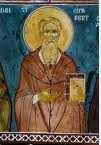
By Augustine Calmet.
St. Gregory the Great relates that St. Benedict having threatened to excommunicate two nuns, these nuns died in that state. Some time after, their nurse saw them go out of the church, as soon as the deacon had cried out, "Let all those who do not receive the communion withdraw." The nurse having informed St. Benedict of the circumstance, that saint sent an oblation, or a loaf, in order that it might be offered for them in token of reconciliation; and from that time the two nuns remained in quiet in their sepulchers.
St. Augustine says that the names of martyrs were recited in the diptychs not to pray for them, and the names of the virgin nuns deceased to pray for them.
"Perhibet præclarissimum testimonium ecclesiastica auctoritas, in quâ fidelibus notum est quo loco martyres et que defunctæ sanctimoniales ad altaris sacramenta recitantur."
It was then, perhaps, when they were named at the altar, that they left the church. But St. Gregory says expressly, that it was when the deacon cried aloud, "Let those who do not receive the communion retire."
The same St. Gregory relates that a young priest of the same St. Benedict, having gone out of his monastery without leave and without receiving the benediction of the abbot, died in his disobedience, and was interred in consecrated ground. The next day they found his body out of the grave: the relations gave notice of it to St. Benedict, who gave them a consecrated wafer, and told them to place it with proper respect on the breast of the young priest; it was placed there, and the earth no more rejected him from her bosom.
This usage, or rather this abuse, of placing the holy wafer in the grave with the dead, is very singular; but it was not unknown to antiquity. The author of the Life of St. Basil the Great, given under the name of St. Amphilochus, says that that saint reserved the third part of a consecrated wafer to be interred with him; he received it and expired while it was yet in his mouth; but some councils had already condemned this practice, and others have since then proscribed it, as contrary to the institutions of Jesus Christ.
Still, they did not omit in a few places putting holy wafers in the tombs or graves of some persons who were remarkable for their sanctity, as in the tomb of St. Othmar, abbot of St. Gal, wherein were found under his head several round leaves, which were indubitably believed to be the Host.
In the Life of St. Cuthbert, Bishop of Lindisfarn, we read that a quantity of consecrated wafers were found on his breast. Amalarius cites of the Venerable Bede, that a holy wafer was placed on the breast of this saint before he was inhumed; "oblata super sanctum pectus positâ." This particularity is not noted in Bede's History, but in the second Life of St. Cuthbert. Amalarius remarks that this custom proceeds doubtless from the Church of Rome, which had communicated it to the English; and the Reverend Father Menard maintains that it is not this practice which is condemned by the above-mentioned Councils, but that of giving the communion to the dead by insinuating the holy wafer into their mouths. However it may be regarding this practice, we know that Cardinal Humbert, in his reply to the patriarch Michael Cerularius, reproves the Greeks for burying the Host, when there remained any of it after the communion of the faithful.
*******
This is taken from Phantom World, originally published in 1850.
Copyright © D. J. McAdam· All Rights Reserved